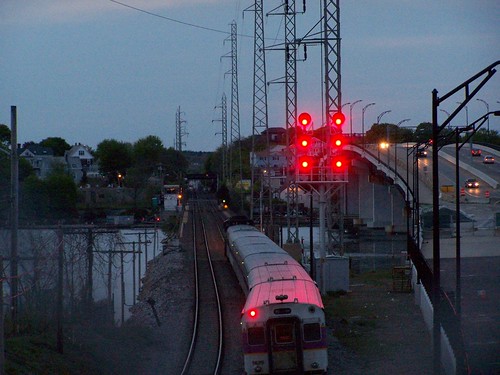 [An evening train to Newburyport going north over the drawbridge.]
[An evening train to Newburyport going north over the drawbridge.]
Finally, after years and years of dismissal, the Press/powers-that-be/official narrative generator finally seem to get public transit. The Boston Globe picks up on this story; Beyond Red & Blue has a post, Subways pick up speed in Boston, trolleys are faster nationally. And so does Robert Reich in, With Gas at $4 a Gallon, We Need Public Transportation, But Why We Can't Get It.
Quote from the Globe:
Commuters continued flocking to the MBTA at a record-setting pace in April, taking 5.5 percent more trips on public transit than they did a year ago, according to T officials.
The agency also said there was a 6.1 percent increase in ridership over the first four months of this year, compared with same period last year. The numbers, which are also reflected nationally, confirm the move from cars to public transit as average gasoline prices jump to nearly $4 per gallon in Boston.
The figures weren't broken out by mode of transport in the Globe article but according to Beyond Red and Blue:
The American Public Transportation Association posted more good news for itself yesterday, reporting that mass transit use went up by 3.3 percent nationwide during the first three months of 2008 compared to the same time in 2007. Boston's MBTA also posted gains, though in a different pattern than found elsewhere.
[...]
Commuter rail ridership nationwide was up by 5.7 percent, thanks in part to double-digit increases in Seattle and Philadelphia, but it was up by only 1.3 percent in the Boston area.
There would be more people taking commuter rail out of Salem but for inadequate parking at Salem Depot. In general, commuter rail is operating at or below capacity on the north side due to lack of equipment, though according to Train Stopping, Newburyport and Rockport have an on-time percentage of 75.1% and 75.8%, remarkable considering the drawbridge problems in Beverly. We badly need double-decker coaches, but don't have them.
Commuter rail is important--Salem has a long, and rich, rail history--but it's not the only mode of transit. Salem has not had trolleys for 70 years, so there are "only" buses for regular everyday transit to the food stores, the doctors and the malls.
As I've written about before (The Car Culture's Limit in Salem), in order for buses to become viable transit for most people, they have to run more often. The 455 is frequently overcrowded during most weekday afternoons; it doesn't help when the T drops trips without notice to save money. The 455 should be running at 15 minute intervals. Or it should be electrified like the trackless trolleys in North Cambridge. I've long wanted to restore real trolleys along the route of the 450.
But there's no money anywhere to improve transit. Robert Reich:
For years, policymakers have wondered just how high gas prices would have to go before drivers switch to public transportation. The answer has been assumed to be very high because Americans supposedly are in love with our cars. Yet now we know there's a tipping point, and it's not quite as high as policymakers have guessed. It's around $4 a gallon. We know that's the tipping point because suddenly millions of Americans are switching to buses, trains and subways to go to work.
Rather than bemoaning this remarkable turnaround we should be celebrating it because public transit not only reduces congestion but also reduces the nation’s energy needs and cuts carbon emissions that bring on global warming.
Problem is, the nation doesn't have nearly enough public transportation to handle the new demand. Even more absurdly, right now when it's needed the most, public transportation across the land is being cut back. This is because transit costs are soaring by the same skyrocketing fuel prices that are forcing people out of their cars, at the same time transit revenues are shrinking because most transit systems depend largely on sales taxes, now dwindling as consumer purchases decline in this recession. A survey of the nation's public transit agencies released last Friday showed 21 percent of rail operators now cutting back and 19 percent of bus operators.
Even though it’s a hundred times more efficient for each of us to stop driving and use trains and buses, there’s not enough money in the public kitty for us to do so.
Public transit has always been the poor stepchild of infrastructure development. America's usual answer to traffic congestion has been to add more lanes on highways, or more highways, or more bridges and tunnels for more cars. America hasn’t been really serious about public transit for almost a century. Most of New York City’s subway system was built over a hundred years ago. Los Angeles ripped out its trams long ago. Boston's Big Dig, one of the biggest infrastructure projects in modern American history, was designed entirely for cars. In recent years, only a few farsighted and ambitious cities, like Portland, Oregon, have invested in light rail.
Instead of public transit improvements on the North Shore, we get a decrepit train station in Salem and a road that is obsolete before it's even opened: Salem's Last Road. It cost $17 million. How much could that have gotten us for transit? At least a new train station.
I've talked and talked with elected and appointed officials, candidates for office and other important persons about public transit. I've always been patronized, patted on my head and sent on my way. Transit has never been that important to Salem politicians.
Will that change now?
1 comment:
Love the blog. I enjoyed reading this post. Some very good and thought provoking points..
Post a Comment